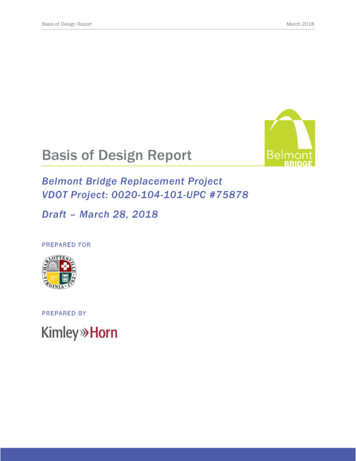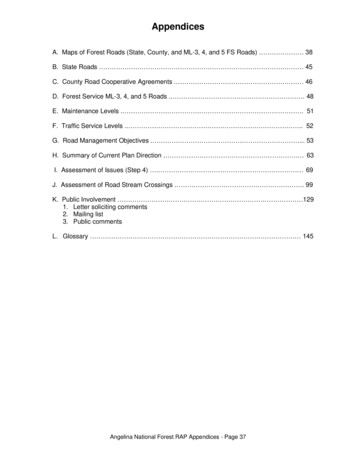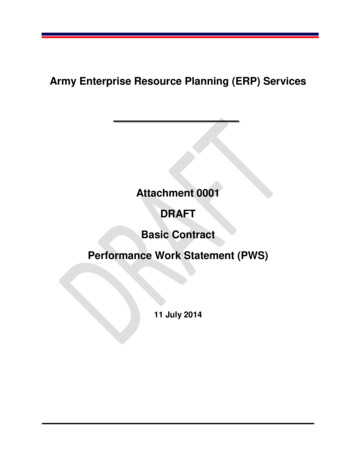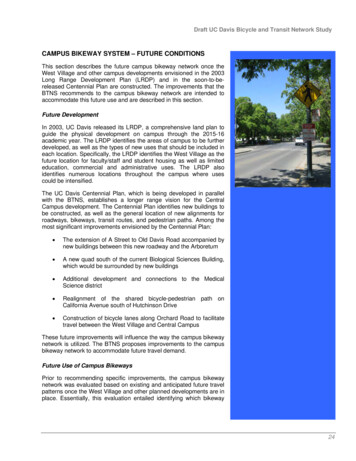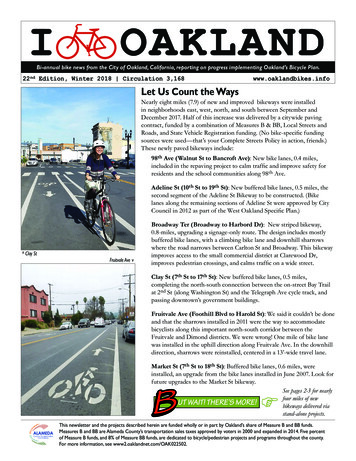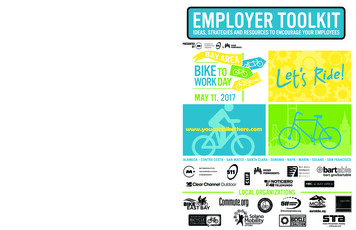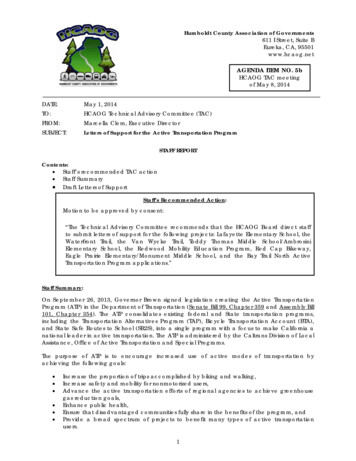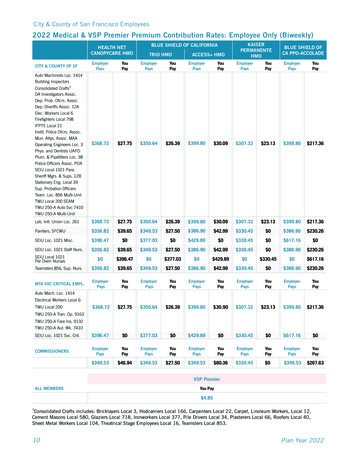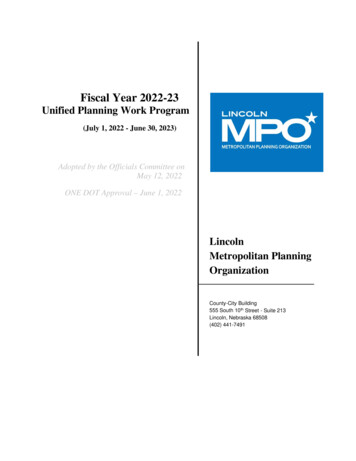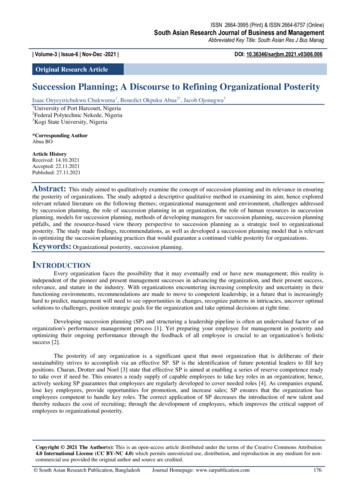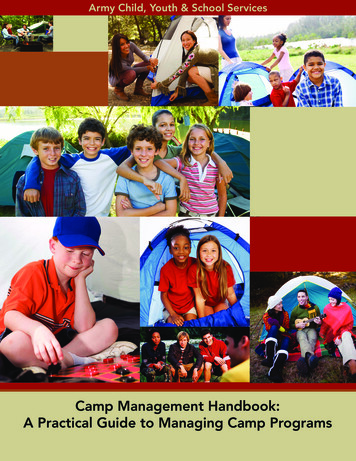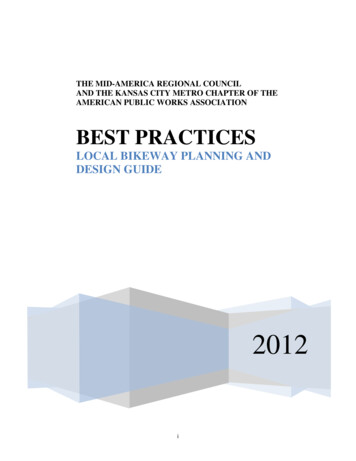
Transcription
THE MID-AMERICA REGIONAL COUNCILAND THE KANSAS CITY METRO CHAPTER OF THEAMERICAN PUBLIC WORKS ASSOCIATIONBEST PRACTICESLOCAL BIKEWAY PLANNING ANDDESIGN GUIDE2012i
TABLE OF CONTENTSChapterPage1.0INTRODUCTION .82.0DEFINITIONS .103.0DESIGNING FOR THE BICYCLE USER .144.03.1BICYCLE USER CHARACTERISTICS .143.2TRIP PURPOSE .153.3PHYSICAL AND COGNITIVE ABILITIES .163.4LEVEL OF USER SKILL AND COMFORT .163.5BICYCLE USER TYPES .16BICYCLE FACILITIES - AN OVERVIEW .174.14.24.3DESIGN OF BICYCLE FACILITIES .184.1.1Shared Roadways .194.1.2Paved Shoulders .214.1.3Wide Curb Lanes .254.1.4Bicycle Routes .264.1.5Bicycle Lanes .294.1.6Shared Use Paths and Sidepaths .31TRAFFIC CONTROL DEVICES BIKEWAY SIGNING AND MARKING .384.2.1Local Bicycle Routes .384.2.2Regional Bikeways .394.2.3Shared Lane Markings .414.2.4Regulatory and Warning Signs .42INNOVATIVE DESIGN TREATEMENTS .44ii
4.3.1Bicycle Lane and Bicycle Route Designs .444.3.2Intersection Traffic Control Treatments .514.4EXPERIMENTAL AND INTERIM APPROVAL TRAFFIC CONTROLTREATMENTS .555.06.07.04.4.1Bicycle Boxes (Experimental) .564.4.2Green Bicycle Lane (Interim Approval Granted) .57BICYCLES AND SIGNALS DETECTION .585.1INDUCTIVE LOOP DETECTORS ILD.595.2VIDEO DETECTION .615.3REMOTE TRAFFIC MICROWAVE SENSOR DETECTION (RTMS) .625.4BICYCLE PUSH BUTTON/BAR .62BICYCLES ON BRIDGES, VIADUCTS AND OVERPASSES .636.1UNDER BRIDGES .656.2TRANSITION AREAS .66STREET UTILITIES .677.1DRAINAGE GRATES AND UTILITY COVERS .688.0BIKEWAY TRANSITIONS .699.0PRINCIPLES AND APPROACHES FOR ROADWAY DESIGN AND RETROFITS .699.110.011.0BIKE LANE RETROFITS .71BICYCLE PARKING .7310.1CLASS I .7410.2CLASS II .7510.3CLASS III .7610.4SHORT-TERM VS. LONG-TERM BICYCLE PARKING .7610.5BICYCLE PARKING LOCATION .77MAINTENANCE AND OPERATION PRACTICES .78iii
12.0TECHNICAL ANALYSIS TOOLS AND MODELS .8012.1BICYCLE COUNTS .8012.2HIGHWAY CAPACITY MANUAL MULTIMODAL LOS.8112.3THE BICYCLE LEVEL OF SERVICE (BICYCLE BLOS) .8212.4SIDEPATH SUITABILITY SCORE .8412.5SPEED-VOLUME MATRIX (SVM) .8712.6 BIKEWAY TREATMENT AND ROADWAY FUNCTIONALCLASSIFICATION .8713.012.7PEDESTRIAN AND BICYCLE CRASH ANALYSIS TOOL (PBCAT) .8912.8GEOGRAPHIC INFORMATION SYSTEM (GIS) .89REFERENCES .90iv
FIGURESFigurePageFigure 1: Shared Roadway Photo19Figure 2: Paved Shoulders Photo21Figure 3: Edgleline Rumble Stripes Illustration24Figure 4: Bicycle Route Photo26Figure 5: Bicycle Lane Photo29Figure 6: Share Use Path Illustration31Figure 7: Trail Crossing Photo35Figure 8: Sidepath Photo36Figure 9: Bicycle Route Sign & Wayfinding Markers Illustration39Figure 10: MetroGreen Sign Illustration40Figure 11: Shared Lane Marking Illustration41Figure 12: Photo Shared Lane Marking41Figure 13: Bike Lane Sign Illustration42Figure 14: Share The Road Sign Illustration42Figure 15: Bicycle May Use Full Lane Illustration43Figure 16: Pedestrian/Bicycle Detour Sign Illustration44Figure 17: Contraflow Bike Lane Photo45Figure 18: Shared Bicycle/Bus Lane Photo46Figure 19: Buffered Bicycle Lane Photo47Figure 20: Raised Bicycle Lane Photo48Figure 21: Bicycle Boulevard Illustration49Figure 22: Cycle Track Photo50Figure 23: Reverse Angle Parking Photo51v
Figure 24: Left Turn Only Bicycle Lane Photo51Figure 25: Mid-Block Crossing Photo52Figure 26: Bicycle Median Illustration52Figure 27: Bicycle Signal Photo53Figure 28: Modern Roundabout Photo54Figure 29: Skewed Railroad Crossing Illustration55Figure 30: Bicycle Box Photo56Figure 31: Green Bicycle Lane Photo57Figure 32: Inductive Loop Detector Symbol Illustration59Figure 33: Inductive Loop Detectors Illustration60Figure 34: Video Layout Image61Figure 35: Bicycle Push Button Photo63Figure 36: Sidepath Along Bridge Photo64Figure 37: Narrow Bridge Sign Illustration66Figure 38: Narrow Bridge Illustration67Figure 39: Bicycle Safe Drainage Grates Photo68Figure 40: Arterial Road Diet Illustration71Figure 41: Arterial Road Diet Illustration72Figure 42: Collector Road Diet Illustration72Figure 43: Collector Road Diet Illustration73Figure 44: Class I Bicycle Parking Photo75Figure 45: Class II Bicycle Parking Photo75Figure 46: Class II Bicycle Parking Photo76Figure 47: Long-term Bicycle Parking Photo77vi
TABLESTablePageTable 1: BLOS Grades . 84Table 2: Sidepath Suitability Score. 86Table 3: Speed Volume Matrix . 87Table 4: Bikeway Treatment & Roadway Functional Class . 88vii
1.0INTRODUCTIONThe Mid-America Regional Council (MARC) led the effort to development this guide withassistance from the Kansas City Metro Chapter of the American Public Works Association(APWA). The purpose of this document is to provide supplemental guidance to local and stategovernments in the planning, designing and construction of bicycle facilities. The section drawssignificantly on national guidelines and standards; however, because guidelines and standardsperiodically update, the responsibility is upon the reader to check the most current information.This section describes a wide variety of bicycle facility accommodations and in each caseprovides appropriate guidance for use. The word shall is used wherever standards have beenestablished. The word should is used to give guidance in the recommendation of appropriateuse, and the word may is used wherever innovative treatments are discussed.The following guide is intended to foster multi-jurisdictional uniformity in the planning, design,and construction of bikeway facilities by establishing common definitions, design guidelines andsystem marking devices. The Mid-America Regional Council and the Kansas City MetropolitanChapter of the American Public Works Association developed this section jointly.Bicycle accommodations are most easily included during new construction or reconstruction ofroadways. When implementation involves retrofitting an existing roadway to betteraccommodate bicycle traffic, the project can become more complex. With each project, theremay be unique challenges and circumstances. The process of reaching design solutions requiresbalancing multiple and sometimes competing factors. As a result, the goal is to reach areasonable solution that has been vetted with stakeholders. It is impossible to cover all thepossible retrofit scenarios and solutions here; however, this section provides general guidance formany common bicycle hazards and retrofit problems. Existing streets built with a curb andgutter section may be limited to re-striping to change the width of existing travel lanes, removinga travel lane or removing on-street parking.8
This section has been prepared based on a thorough review of current planning guidelines, anddesign standards for bicycle facilities. It is consistent with professional guidelines set forth by theAmerican Association of State Highway and Transportation Officials (AASHTO), the Manual onUniform Traffic Control Devices (MUTCD), the Federal Highway Administration (FHWA), theMissouri Department of Transportation (MoDOT) and the Kansas Department of Transportation(KDOT). This section will require periodic updates to reflect changes in professionaldocuments.9
2.0DEFINITIONSThe coordination of a multi-jurisdictional bikeway system is simplified by using standardizedterminology. Often terms such as “bicycle lane” and “bicycle path” are used interchangeably,when, in fact, they are not equivalent. It is difficult to coordinate regionally wheninconsistencies in the use and meaning of terms exist. Therefore, as local jurisdictions aredeveloping and updating their own plans and policies, they are encouraged to use the followingterms consistently with the definitions that follow.This section is intended to provide a central location for bicycle-related definitions as defined bynationally recognized authorities. AASHTO definitions relate to planning, design and operationof bikeway facilities. The MUTCD is the national standard for all traffic-control devicesinstalled on any street, highway, bikeway, or private road open to public. All terms are based onAASHTO or MUTCD unless otherwise noted. Text that is marked in Italic font indicates whereadditional clarification was deemed appropriate. In some cases, notes are provided to explainwhy AASHTO and MUTCD definitions differ. Notes are not part of the definition.The use of AASHTO and MUTCD definitions are necessary when coordinating multijurisdictional systems, however; we recognize that terms such as “trail” may be more appropriatewhen used in a general public context.If local jurisdictions decide to substitute a term like “path” for “trail” it is important that theseterms are well defined in a plan or policy document so that it is clear how the modified termcompares to AASHTO or MUTCD definitions. The following terms are listed in alphabeticalorder and shall be defined as follows when used in this document.BICYCLE or BIKE — a pedal‐powered vehicle upon which the human operator sits. The term“bicycle” for this publication includes three and four‐wheeled human‐powered vehicles, but nottricycles for children. (See References, AASHTO (1) Page 2)BICYCLE BOULEVARD — a street segment, or series of contiguous street segments, that hasbeen modified to accommodate through bicycle traffic but discourage through motor traffic. (SeeReferences, AASHTO (1) Page 2)10
BICYCLE CARRIER — a device mounted to a motor vehicle (often a bus) which is designedto transport one or more bicycles. (MARC)NOTE: The AASHTO definition includes only roadways designated for bicycle use, but theMUTCD definition includes all roadways where bicycle travel is legally permitted. TheAASHTO definition is used throughout this document.BICYCLE LANE or BIKE LANE — a portion of a roadway which has been designated bypavement markings and, if used, signs, for the preferential or exclusive use of bicyclists. (SeeReferences, AASHTO (1) Page 2)BICYCLE LEVEL OF SERVICE (BLOS) — a model used to estimate bicyclists’ averageperception of the quality of service of a section of roadway between two intersections. (SeeReferences, (1) Page 2)BICYCLE LOCKER or BIKE LOCKER — a secure, lockable container used for long‐termindividual bicycle storage. (See References, AASHTO (1) Page 2)BICYCLE MAP — a suggested route or network of routes for cycling published in a mapformat. Organizations that do not have the authority to sign a bicycle route, such as a bicycleclub, may publish suggested routes for cycling and in some case, local governments may publishsuggested routes such as paved shoulders and wide curb lanes, which are not signed as a bikeroute. (MARC)BICYCLE PATH or BIKE PATH — a pathway that is exclusively used by bicyclists, where aseparate, parallel path is provided for pedestrians and other wheeled users. Most pathways areshared between bicyclists and other users: see Shared Use Path. (See References, AASHTO (1)Page 4)BICYCLE RACK or BIKE RACK — a stationary fixture to which a bicycle can be securelyattached. (See References, AASHTO (1) Page 2)BICYCLE ROUTE — a roadway or bikeway designated by the jurisdiction having authority,either with a unique route designation or with BIKE ROUTE signs, along which bicycle guidesigns may provide directional and distance information. Signs that provide directional, distance,and destination information for cyclists do not necessarily establish a bicycle route. (SeeReferences, AASHTO (1) Page 3)BICYCLE NETWORK — a system of bikeways designated by the jurisdiction havingauthority. This network may include bike lanes, bicycle routes, shared use paths, and otheridentifiable bikeways with appropriate way finding information with or without specific bicycleroute numbers. The network uses a combination of bikeway types to create a continuous andconnected system. (See References, AASHTO (1) Page 3)BIKEWAY — a generic term of any road, street, path or way which in some manner isspecifically designated for bicycle travel, regardless of whether such facilities are designated for11
exclusive use of bicycles or are to be shared with other transportation modes. (See References,AASHTO (1) Page 3)CYCLE TRACKS — is an exclusive bike facility that combines the user experience of aseparated path with the on-street infrastructure of a conventional bike lane. A cycle track isphysically separated from motor traffic and distinct from the sidewalk. Cycle tracks havedifferent forms, but all share common elements—they provide space that is intended to beexclusively or primarily used for bicycles, and are separated from motor vehicle travel lanes,parking lanes, and sidewalks. In situations where on-street parking is allowed cycle tracks arelocated to the curb-side of the parking (in contrast to bike lanes). (See References, NACTO (3) )RAIL-TRAIL — a shared use path, either paved or unpaved, built within the right-of-way of aformer railroad. (See References, AASHTO (1) Page 3)RAIL-WITH -TRAIL — a shared use path, either paved or unpaved, built within theright‐of‐way of an active railroad. (See References, AASHTO (1) Page 3)RIGHT-OF-WAY — a general term denoting land, property or interest therein, usually in astrip, acquired for or devoted to transportation purposes. AASHTO (1)ROADWAY — the portion of the street (or paved traveled way), including shoulders, intendedfor vehicular use. (See References, AASHTO (1) Page 3)SHARED LANE — a lane of a traveled way that is open to bicycle travel and (motorized)vehicular use. AASHTO (1)NOTE: This term is a broad definition because it includes all roadways that permit bicycle travelin the traveled way including preferred bike routes but excluding shoulders because they are notintended for motorized vehicular travel and bike lanes because they are for bicycle travel only.SHARED LANE MARKING — a pavement marking symbol that indicates an appropriatebicycle positioning in a shared lane. (See References, AASHTO (1) Page 3)SHARED ROADWAY — a roadway that is open to both bicycle and motor vehicle travel. Thismay be an existing roadway, a street with wide curb lanes, or a road with paved shoulders. (SeeReferences, AASHTO (1) page 4)SHARED USE PATH — a bikeway physically separated from motorized vehicular traffic by anopen space or barrier and either within the highway right-of-way or within an independent rightof-way. Shared use paths are also used (for transportation and/or recreation) by pedestrians,skaters, wheelchair users (both nonmotorized and motorized), joggers and other non-motorizedusers. AASHTO recommends a minimum of 10 feet width (in rare cases, 8 feet). (SeeReferences, AASHTO (1) Page 4)NOTE: The AASTHO and MUTCD definitions are nearly identical. During the update of thisguide, the Access Board released accessibility guidelines for shared use paths under Americans12
with Disabilities Accessibility Guidelines (ADAAG). The ADAAG definition is consistent withboth AASHTO and MUTCD.SHOULDER — the portion of the roadway contiguous with the traveled way, foraccommodation of stopped vehicles, emergency use and lateral support of sub-based, base andsurface courses, often used by cyclists where paved. (See References, AASHTO (1) Page 4)SIDEWALK — that portion of a street or highway right‐of‐way, beyond the curb or edge ofroadway pavement, which is intended for use by pedestrians. (See References, AASHTO (1)Page 4)SIDEPATH — a shared use path located adjacent and parallel to a roadway. (See References,AASHTO (1) Page 4)NOTE: The adverb “immediately” appears after “located” and in the AASHTO definition wasremoved because it implies that there is no space between the roadway and sidepath. Sidepathsare within the ROW and should be separated from the travel way by open space or physicalbarrier. (See Section 4.1.6 Shared Use Paths and Sidepaths)TRAVELED WAY — the portion of the roadway intended for the movement of vehicles,exclusive of shoulders. (See References, AASHTO (1) Page 4)UNPAVED PATH — path not surfaced with a hard, durable surface such as asphalt or Portlandcement concrete. (See References, AASHTO (1) Page 4)NOTE: Most local agencies, state and federal agencies use the term “trail” to describe bothpaved and unpaved pathways. This term is appropriate to use but may require further definitionto distinguish trail typology (paved, unpaved, equestrian, mountain bike, nature hike, etc.).WIDE-CURB LANE – the outside lane next to the curb having a width of 13 feet or greater. Awidth of at least 14 feet allows a motorist to pass a bicyclist without encroaching into theadjacent lane. (See References, AASHTO (1) Page 57)NOTE: The DRAFT AASHTO Guide for the Planning, Design, and Operation of BicycleFacilities provides guidance wide-curb lane design. There is no singular definition found in theDRAFT; however, the definition above is derived from Chapter 4.3.1. SHARED LANES ONMAJOR ROADWAYS (WIDE CURB/OUTSIDE LANES).13
3.0DESIGNING FOR THE BICYCLE USERThe planning and design of bicycle facilities requires a clear understanding of user types, theirneeds and how to meet those needs while accommodating other transportation modes.Many people are attracted to bicycling because it is a healthy, low cost affordable, energyefficient, environmentally friendly, and relaxing form of transportation. The bicycle increasesmobility, creating access to jobs, goods, services, and recreational opportunities. For manypersons, bicycling is a viable transportation mode for trips that are 2 miles or less in length.When combined with transit service, trip lengths can be much longer.The United States Department of Transportation Policy Statement on Bicycle and PedestrianAccommodation Regulations and Recommendations supports transportation programs andfacilities that accommodate people of all ages and abilities, including people too young to drive,people who cannot drive, and people who choose not to drive. The Mid-America RegionalCouncil conducts regional analysis population demographics to understand present and projectedtransportation needs. While each community is unique, the region’s population is aging, and it isexpected that people over age 60 will increase from 15 percent to 25 percent by 2030. Youngpeople are expected to decline slightly as a total share of the region’s population, but willincrease by 78,000 over the next 20 years. A substantial number of area households requiretransportation options other than a personal motor vehicle. Many cannot afford to own andoperate a vehicle. According to the region’s 2004 Regional Household Travel Survey, 48,919households (8.7 percent of all households) own no motor vehicle, and 227,873 households (40.8percent of all households) have only one vehicle.3.1BICYCLE USER CHARACTERISTICSEffective planning and design of bicycle facilities both on and off road requires a generalunderstanding of the characteristics that are used to classify different types of bicycle riders. Trippurpose, physical ability, and comfort/skill level are among the most common. All of thesecharacteristics are dynamic, causing individuals to fit into one or more profiles.14
3.2TRIP PURPOSEUtilitarian / NondiscretionaryThe utilitarian or nondiscretionary trip includes daily destinations such as work, school andshopping. This type of trip requires the rider, when choosing a route, to consider safety, trip time,and comfort level in addition to the destination. The growth in utilitarian trips has been fueled byseveral factors, including personal health, cost of transportation and concern for the environment.For reasons of age or finances, an individual may not have access to an automobile making themdependent on other modes of transportation namely walking, public transit, and bicycling.Recreational / DiscretionaryThe recreational or discretionary trip is made for exercise or enjoyment. The focus of this trip isnot a destination but rather the activity. The bicyclist still considers safety, trip time, and comfortlevel, but may weigh them differently.A bikeway network that serves both utilitarian and recreational trips is important because itaffects the quality of life of all users. The differences between trip types can become blurredwhen the purpose of a trip is both utilitarian and recreational. A planner or designer of bicyclefacilities must understand that the bikeway network of roads and pathways should serve both trippurposes.Communities are rethinking the role that transportation plays in addressing public health,economics, and environmental stewardship. These issues are cross-cutting, and they apply toboth utilitarian and recreational trips. “Active Transportation” is an approach to transportationplanning and design that encourages bicycling and walking. The focus is on transportation thatintegrates daily physical exercise to improve the quality of life of the individual and theircommunity. Recreation and discretionary trips also may form a daily routine that creates anactive transportation lifestyle.15
3.3PHYSICAL AND COGNITIVE ABILITIESIndividual riders have a number of characteristics that affect their physical and cognitiveabilities. Adults and/or children both have different levels of physical and cognitive abilities.However, children tend to be different from adults in the following ways. They: are more impulsive, lack understanding of cause and effect relationships, are distracted by unimportant information, have difficulty determining where a sound is coming from, have difficulty judging the speed and distance of oncoming vehicles, lack the peripheral vision, and lack physical coordination.As adults age our physical coordination, and stamina diminish, our eyesight, hearing andcognitive abilities also diminish.3.4LEVEL OF USER SKILL AND COMFORTWith education, training and experience the casual rider becomes more confident, building skillsthat increase their comfort level. In general, the more experienced a rider is the less likely thatspeed and traffic volume affects their comfort level. Less experienced riders tend to prefer totravel on low-traffic residential streets or shared-use paths but may be less aware of potentialrisk. Public education should be provided to assist riders in choosing routes that are appropriatefor their skill and equipment.3.5BICYCLE USER TYPESA 1994 report by the Federal Highway Administration, Selecting Roadway Design Treatmentsto Accommodate Bicycles used the following general categories of bicycle user types (A, B, andC) to assist transportation planners and engineers in determining the impact of different facilitytypes and roadway conditions on bicycles:16
Advanced or (experienced) cyclists are generally using their bicycles as they would a motorvehicle. They are riding for convenience and speed and want direct access to destinations with aminimum of detour and delay. They are typically comfortable riding with motor vehicle traffic;however, they need sufficient operation space on the traveled way or shoulder to eliminate theneed for them or a passing motor vehicle to shift position.Basic or (novice) or less confident adult cyclists may also use their bicycles for transportationpurposes, e.g., to go to the store or to visit friends, but prefer to avoid roads with fast busy motorvehicle traffic unless there is ample roadway width to allow easy overtaking by faster motorvehicles. Thus, basic riders are comfortable riding on a neighborhood street, shared use pathsand prefer designated facilities such as bike lanes or wide curb lanes on busier streets.Children riding on their own or with their parents, may not travel as fast as their adultcounterparts but still require access to key destinations in their community, such as schools,convenience stores, and recreational facilities. Residential streets with low motor vehicle speeds,well-defined bike lanes or shared used paths can accommodate children without encouragingthem to ride in the travel lane of the busy roadways. (4)4.0BICYCLE FACILITIES - AN OVERVIEWThe AASHTO defines “bicycle facilities” as a general term denoting improvements andprovisions to accommodate or encourage bicycling, including parking and storage facilities, andshared roadways specifically designated for bicycle use. Section 4.1 describes a wide variety ofbicycle facilities. Purpose, appropriate applications, and special considerations are among thetopics covered professional judgment, and sound engineering practices must be used on the sitespecific application of any design treatment.Both on-street and off-street bicycle facilities and designation types are used to accommodatebicycle travel. Options included: Shared Roadways/Shared Lanes (on-road)17
Paved Shoulders (on-road) Wide Curb Lanes (on-road) Bicycle Routes Bike Lanes (on-road) Share Use Paths (off-road)Note: Shared roadways, roadways with wide curb lanes or paved shoulders may or may not bedesignated bike routes, but all fall under the definition of bicycle facilities. AASHTO defines abike route as a designation of a preferred route or bikeway rather than a design type.4.1DESIGN OF BICYCLE FACILITIESNot all roadways equally accommodate bicycle travel. The choice of where improvements aremade and which roadways are designated as part of bikeway network entails the consideration ofmultiple factors, including but not limited to: user needs, traffic volumes and speeds, barriers,connections to land uses, route directness, aesthetics, bikeway network density, and overallfeasibility.This document describes a wide selection of possible bicycle facility accommodations. There isno one size-fits-all bicycle facility or roadway design that suits every bicyclist and no bicyclefacility design can compensate for a lack of bicycle operator skill and competency. As a result,sound planning and design principles
BICYCLE NETWORK — a system of bikeways designated by the jurisdiction having authority. This network may include bike lanes, bicycle routes, shared use paths, and other identifiable bikeways with appropriate way finding information with or without specific bicycle route numbers. The network uses a combination of bikeway types to create a .
